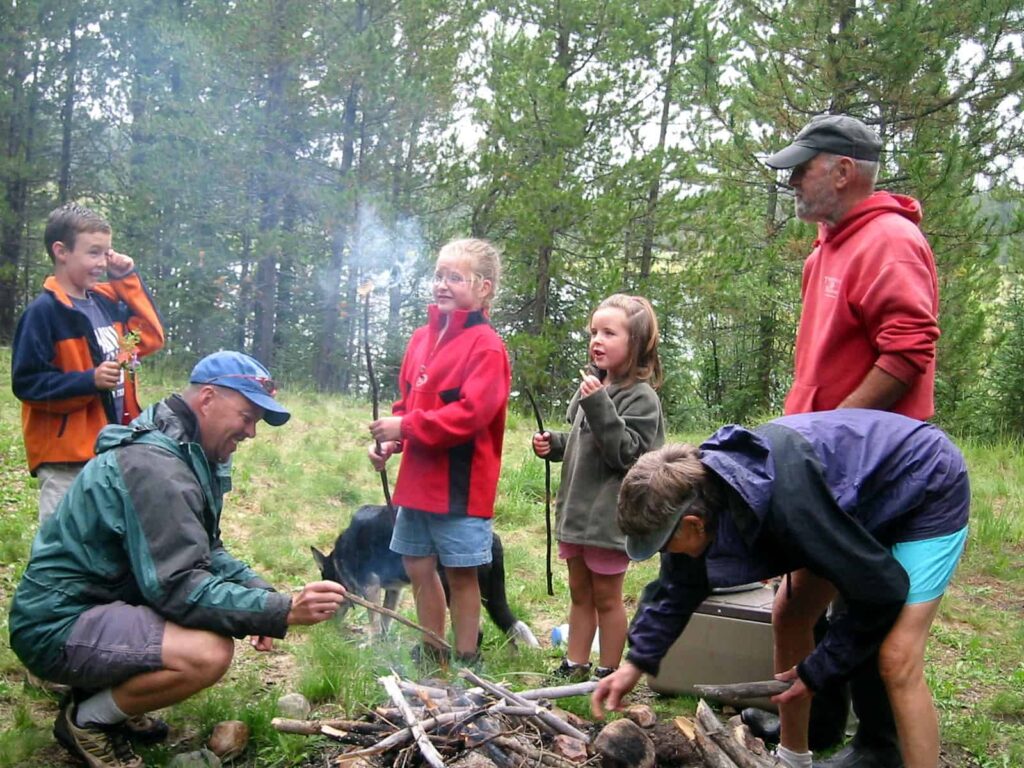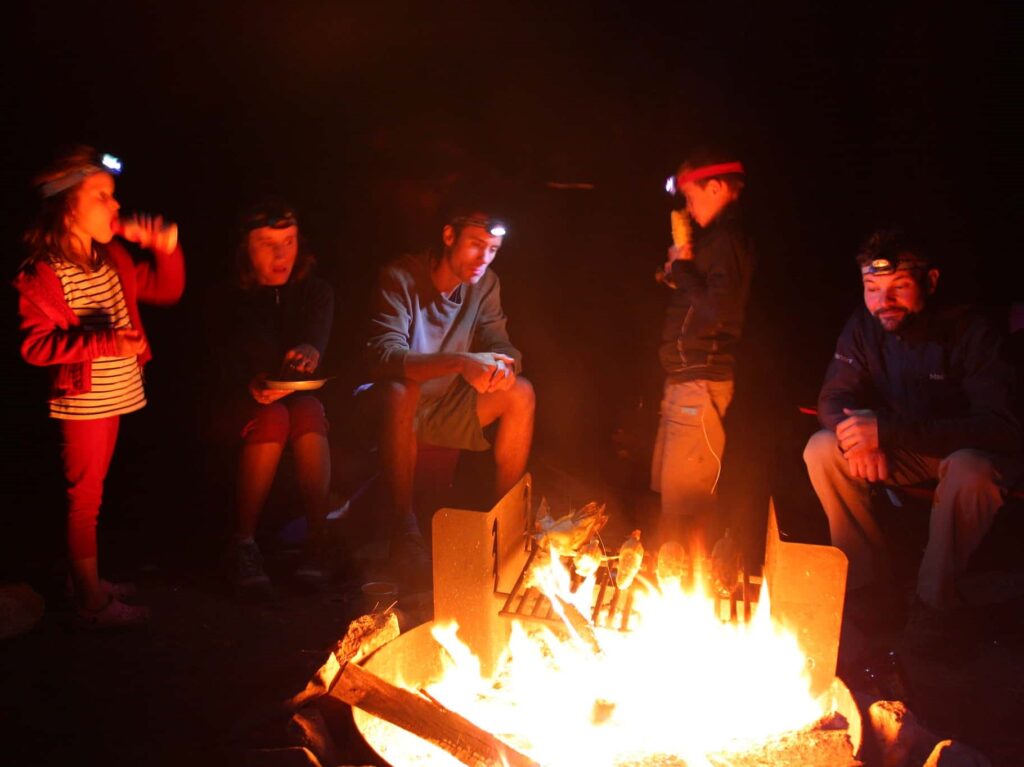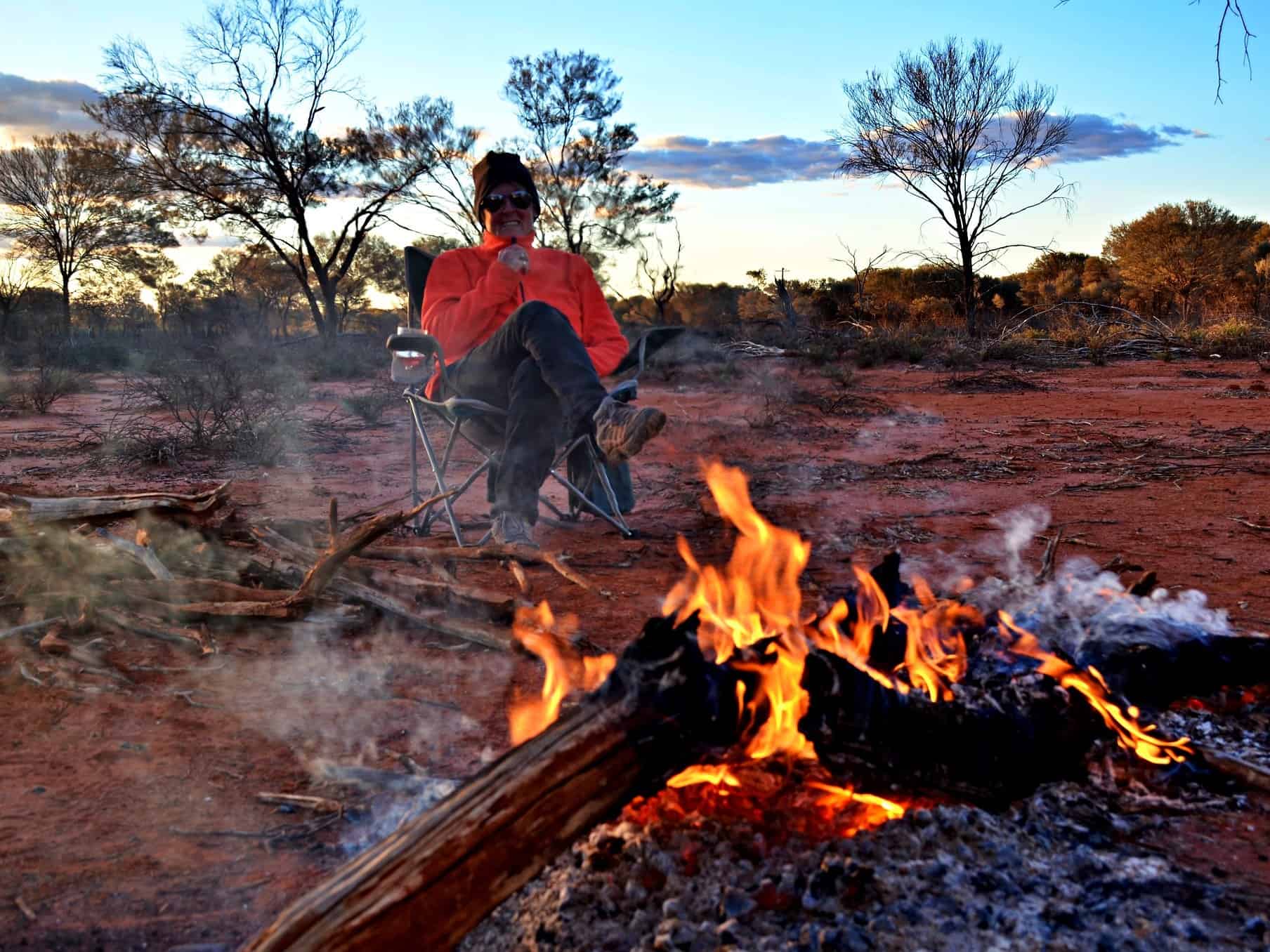Last updated on January 19th, 2023 at 01:48 pm
I love camping, especially the evenings spent relaxing around the campfire. But there’s nothing more annoying than the campfire smoke that seems to stalk you no matter where you are. If you’ve ever wondered why does campfire smoke follow you everywhere you go, we’ve got your answer.
Campfire smoke follows you because of all the air currents around you. While it’s impossible to remove those air currents, you can minimize their effects.
How Campfires Work
First and foremost, fire requires oxygen, fuel, and heat. The process itself is known as combustion, and the wood acts as your fuel. As it burns, the kinetic energy increases, which subsequently decreases the density of the warm air.
Then, as the warm air rises due to its gravitational-induced buoyancy, fresh oxygen is drawn in from the bottom of your fire.
To understand why smoke follows you around, you must first understand the science of a campfire. Have you ever wondered why a flame burns upwards when gravity brings everything else down? The answer is gravitational-induced buoyancy.
Why Smoke Follows You Around a Campfire
In layman’s terms, when starting a fire, the fuel and oxygen combine to release heat.
As the air around the flame heats up, it becomes less dense. Because the hot air is less dense, it rises just like a cork rises to the surface of the water.
As the warm air rises, the fire’s need for oxygen sucks in the cool air from the surface area of the ground. But how does this affect the smoke?
Well, if your body is in between the cool air and the fire, this directly impacts the atmospheric pressure.
Basically, you get in the way of the oxygen flow, and as a result, the smoke drifts towards you. However, if you sit still, you may be able to avoid creating updrafts and differences in pressure. Check out our post where we find the Best Camping Chair.

Because your presence prevents the air behind you from flowing towards the fire, you’ve created an imbalance in the airflow.
Instead of having equal airflow from all sides of your fire, you now only have airflow from the opposite side.
This imbalance causes the smoke to move directly towards you. And this will happen regardless of where you move.
Furthermore, the more people you have around the fire, the more blockage of airflow you have. This makes the vacuum even stronger.
Another reason you seem to be a magnet for campfire smoke is because of tailwinds.
Even though you can’t see them, any movement whatsoever creates these one-directional vacuums. Whenever you create a tailwind, it essentially sucks the smoke right towards you.
And finally, Mother Nature itself plays a large role in the direction of the smoke. The wind itself carries the smoke in whatever direction it may be traveling.
Similar to water, smoke travels the path of least resistance.
Why Does Fire Smoke
Smoke is a byproduct of the compounds in your wood that don’t completely burn. This is known as incomplete combustion, which occurs because your fire isn’t hot enough or because it doesn’t have enough oxygen.
Smoke is actually a collection of all of these tiny compounds that cannot be seen with the naked eye. However, when all of these unburned particles accumulate together the result is what we call smoke (source).
Additionally, the amount of smoke has a lot to do with the type of wood being burned.
For example, hardwood smokes a great deal more than softwood. Likewise, green wood smokes more than dry wood. In fact, green wood like wet wood produces more smoke because of its water content preventing compounds from combusting.
How Do You Make a Smoke Free Fire
If you’re overly concerned with the question ‘why does campfire smoke follow you,’ you may now be wondering if there is such a thing as a smoke-free fire. First, you’ll never be able to build a campfire that’s completely smoke-free. However, there are a few tricks that will at least help you keep the smoke out of your face.

1) Stack your wood properly.
Placing your logs parallel to one another provides your fire with sufficient oxygen. This allows plenty of airflow, which in turn will keep your logs from smoldering.
2) Use a grate.
Building your fire over a grate elevates your logs off of the ground. This helps distribute both airflow and heat evenly.
3) Use dry wood.
As mentioned, the drier the wood, the less smoke it produces. Additionally, avoid tossing things like dry leaves, pine needles, or dead grass into your fire. These items typically smoke a great deal.

4) Build a Dakota Fire
A Dakota fire pit is dug into the ground and works essentially the same as a rocket stove. Start by digging a large hole big enough to house your fire, at least one foot wide and two feet deep.
Then approximately one foot away from that hole, dig a second hole on the smaller side. Roughly eight inches wide and a foot deep should be sufficient.
Once your holes are dug, tunnel your way from the small hole to the larger one. Your fire will pull the oxygen through the second hole while eliminating any imbalances in the airflow.
5) Keep your fire small
The smaller the fire the less amount of smoke it will produce. If heat is your ultimate goal, drier wood results in a hotter fire. So you don’t necessarily need a large fire to stay warm.
6) Switch to a Portable Propane Fire Pit
Additionally, campers can make the switch to propane instead of wood combustion. In fact, there are plenty of amazing and safe models on the market that we test in our Best Portable Gas Fire Pit for Camping post.
How Do I Stop My Campfire from Smoking in My Face
Aside from smokeless fires, there are other things you can do to decrease the amount of smoke constantly bombarding you.
1) Sit still or sit further away
If you sit further away from the fire, you’re less likely to impede the airflow. Usually, a five-foot perimeter works best. This means you’ll have equal airflow on all sides preventing any one-directional attacks.
Additionally, if you’re enjoying the evening with friends and family, symmetry is your goal. By spacing everyone at equal distances around your campfire, you’re able to keep the airflow around your fire balanced.
Remember as long as the flow is balanced, then the air current pulls the smoke up to the sky.
2) Don’t create a tailwind
Also, remember the more you move around the more air currents you create. Those tailwinds pull the smoke directly toward you.
Therefore, the less you move around, the more smoke-free your personal space will be.

3) Work with the wind
Furthermore, try sitting upwind from your campfire. Remember, smoke will travel the path of least resistance. So, the wind will naturally carry the smoke away from you.
If the wind is swirling about sporadically, then opt to set up a decoy nearby. Regardless of where you are seated, as the wind blows around you, it creates a low-pressure zone.
By default, this will attract the smoke towards you. However, setting up a decoy between you and the fire will draw the smoke towards the decoy instead.
4) Create a smoke-free fire
Another way to create a smoke-free fire is to create a fire ring of stones in the shape of a horseshoe. In the “U” part of the shape, place an exceptionally large stone. Imagine it as the tombstone of your firepit.
The open end of the horseshoe will increase the oxygen flow and the tombstone will act as a decoy. The smoke will always gravitate towards the large rock as it is the barrier blocking the oxygen from the opposite side.
5) Don’t have a wood fire
The final option is, of course, to not have a fire at all. If you’d rather not deal with the hassle of smoke, then this might be the better option for you.
But then again, you’ll have to figure out a different way to stay warm on those frosty nights. There are a few things you can do to help preserve your body’s warmth.
First, use a barrier between you and the ground. Heat will always transfer from hot to cold. To avoid losing your body heat to the cold ground, have a pad to sit or lay on.
In addition, you want something to break the wind, especially if it’s coming from the north with its sharp bite. You need a non-breathable material to protect your skin. Windbreakers or rain gear are both good choices.
Finally, for car campers or the backyard, a portable propane fire pit is a great smoke-free option compared to wood combustion.
Check out our favorite portable propane fire pits in our post Best Portable Gas Fire Pit for Camping.
Also, adding additional layers of insulation helps.
Hand and feet warmers are always a coveted luxury on those really cold nights. Dropping them in your shoes, gloves, or pockets help keep those fragile extremities nice and toasty.
At the very least, adding some extra calories to your evening meal and staying active will better control your personal thermostat. Cook food an warm water for hot water bottles with models from our Best Camping Stove post.
How to Color Your Fire
Additionally, some campers enjoy adding a little color to their campfires to liven up the night. In most cases, this can be accomplished through over-the-counter powders. The other option is to soak your wood or fire starter in premade solutions. But then you have to mess with the whole drying process, which can be rather time-consuming.

If you’d like to experiment with adding some color to your campfire or bonfire, here are some easy store-bought items you can try:
- Table salt (sodium chloride) produces a yellowish flame.
- Borax (laundry booster) produces a yellowish-green flame.
- Epson salt (magnesium sulfate) produces a white flame.
- Soda ash (sodium carbonate) produces a yellow flame.
- Boric acid produces a green flame.
- Potassium chloride (vitamin supplement) produces a purple flame.
- Potassium sulfate (vitamin supplement) produces a violet flame.
Toss a small amount of powder into your next campfire, and watch your flames dance to the tune of a different color.
However, be careful not to inhale the smoke from any of these chemical compounds and wash hands thoroughly after adding to the fire.
Smoke Follows Moving Targets
In summary, you can enjoy the cozy warmth of the campfire without being constantly suffocated by its smoke. These few campinng hacks allow you to better manage the smoke that so often infiltrates the campfire circle. Plus, now you even know how to liven up your campfire with a little color for some extra festivities.
Try any one of these methods on your next camping trip and be amazed by a much more enjoyable experience. Better yet, try a combination of these hacks and experience the ease of a smoke-free night around the fire.
About the Author
Sarah Sampsell
Title Image Credit, Why Does Campfire Smoke Follow You: Chris Fithall | (source) | Attribution 2.0 Generic (CC BY 2.0) — reduced file size and image
family green Why Does Campfire Smoke Follow You, Image Credit 1: JBColorado | (source) | Attribution-NoDerivs 2.0 Generic (CC BY-ND 2.0) — reduced file size and image
Why Does Campfire Smoke Follow You, Image Credit 2: Dave Hernolz | (source) | Attribution-ShareAlike 2.0 Generic (CC BY-SA 2.0) — reduced file size and image
Image Credit 3, Why Does Campfire Smoke Follow You: Mark Doliner | (source) | Attribution-ShareAlike 2.0 Generic (CC BY-SA 2.0) — reduced file size and image
Image Credit 4, Why Does Campfire Smoke Follow You: University of Michigan School of Environment and Sustainability | (source) | Attribution 2.0 Generic (CC BY 2.0) — reduced file size and image
Why Does Campfire Smoke Follow You, Image Credit 5: B Rosen | (source) | Attribution-NoDerivs 2.0 Generic (CC BY-ND 2.0) — reduced file size and image

